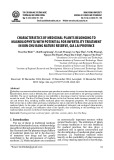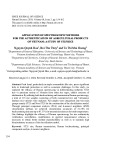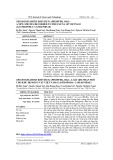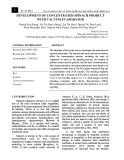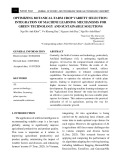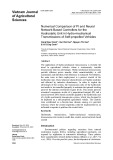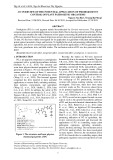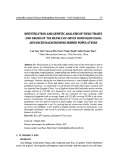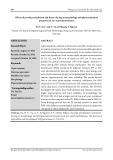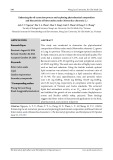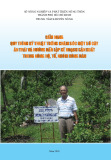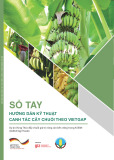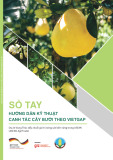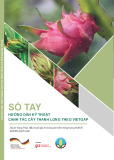
Int.J.Curr.Microbiol.App.Sci (2020) 9(11): 1510-1515
1510
Original Research Article https://doi.org/10.20546/ijcmas.2020.911.179
Sodium Chloride (NaCl) and Hydrogen Peroxide (H2O2) Induced Changes
in Antioxidant Enzymes (SOD, CAT, and POX) of Contrasting Wheat
Cultivars under Favourable Growth Conditions
Santosh Kumari1* and Vipin Kumar Verma2
1Division of Plant Physiology, Indian Agricultural Research Institute, New Delhi, India
2Department of Pharmacology, All India Institute of Medical Sciences, New Delhi, India
*Corresponding author
A B S T R A C T
Introduction
Plants adjust their antioxidant enzymes to
avoid cellular injury due to oxidative stress
triggered by reactive oxygen species.
Superoxide dismutase (MnSOD, FeSOD and
CuZnSOD) a group of metal-enzymes
dismutase the superoxide radical to hydrogen
peroxide. Catalase detoxifies H2O2 to water
and oxygen. Peroxidases catalyze lignin
polymerization using monolignols (coniferyl,
sinapyl p-coumaryl alcohols) and H2O2 in the
apoplastic space, modify cell walls
incorporating suberin. Lignin is present in
xylem vessels and xylem fibers in high
concentrations. Peroxidases play role in the
cell wall loosening and cell elongation via
generation of hydroxyl radicals (OH radical)
with the ability to chop cell wall
polysaccharides. Peroxidases stiffening of cell
wall by cross linking cell wall protein and
ferulic acid residues in polysaccharides and
cessation of cell elongation.
Superoxide, hydrogen peroxide and hydroxyl
radicals are continuously generated in
International Journal of Current Microbiology and Applied Sciences
ISSN: 2319-7706 Volume 9 Number 11 (2020)
Journal homepage: http://www.ijcmas.com
Differential response of CAT1, CAT2 and CAT3 indicated the positive correlation of
catalase and H2O2 accumulation in C306 under control, H2O2, NaCl and NaCl+H2O2
treatments accompanied with enhancement of SOD activity in flag leaves of the drought
tolerant wheat cultivar. SOD activities provide extra protection in combination with
catalase in wheats under oxidative stresses. The POX and SOD activity enhancement in
flag leaves was positively associated with plant height and leaf size reduction under salt
stress in wheats. The differential accumulation of H2O2 is cultivar specific and associated
with SOD isoforms (CuZnSOD) that is involved in lignin biosynthesis. CuZnSOD or CAT
were not inhibited under salt stress suggest that it is superoxide rather than other forms of
ROS mediating proline oxidase induced apoptosis. Proline accumulation/ oxidation alter
the intracellular redox status by proline oxidase inhibition by MnSOD and superoxide
dismutation to H2O2 which is utilised by POX for lignin biosynthesis.
K e y w o r d s
Catalase, Hydrogen
peroxide,
Peroxidase, Sodium
chloride,
Superoxide
dismutase, Wheats
Accepted:
12 October 2020
Available Online:
10 November 2020
Article Info

Int.J.Curr.Microbiol.App.Sci (2020) 9(11): 1510-1515
1511
respiration and photosynthesis. ROS serve as
signalling molecules similar to
phytohormones. ROS accumulation modifies
cell walls, root elongation, leaf expansion,
biomass accumulation plant growth and
development, therefore, plant productivity.
Drought and salinity affect plant molecular,
biochemical and physiological processes via
ROS (Smirnoff, 1993, Hasegawa et al., 2000).
Plants modulate the antioxidant enzymes to
alleviate the cellular injury caused by ROS
(Foyer and Noctor, 2005).
The production of both ABA and H2O2 is
induced by water stress and drought due to
salt stress; can act as signals under stress
conditions. Therefore, we investigated the
relationships between ABA, salt stress, H2O2,
accumulation and changes in antioxidants
enzymes under favourable growth conditions.
Wheat is an important staple food crop
worldwide. Therefore, the study was
undertaken to identify the marker antioxidant
enzymes of drought sensitive and drought
tolerant wheat cultivars those may be helpful
in plant breeding for salt tolerance.
Materials and Methods
Drought sensitive wheat cultivar, HD2428
and drought tolerant wheat cultivar- C306
were grown under normal environment for
growth and development (November 15,
2018) to expose them to normal and oxidative
stress environment under late sown
conditions. Plants were grown in a
greenhouse green house in earthen pots (size
30x30 cm) filled with sandy loam soil and
farmyard manure in 3:1 under natural
environment. Each pot was fertilized
corresponding to 120, 90 and 60 kg ha-1 of N,
P and K, respectively. Plants were kept free
from diseases. Twenty pots were used for
H2O2 (10 mM) spray treatment, NaCl (200
mM) soil application and H2O2 (10 mM)
spray treatment after five days of NaCl
treatment. Twenty pots were used for seeds
harvested from 15 January 2017 grown plants
and sown in the normal season (November
15, 2018) for epigenetic phenotypes
characterization.
Fresh flag leaves samples were ground in
liquid nitrogen and homogenized in 50 mM
sodium phosphate buffer (pH 7.0) containing
2 mM EDTA and 4% (w/v) PVP-40 and
centrifuged at 10000 g for 20 min at 4⁰C.
The supernatant was used for protein
estimation (Bradford 1976). Antioxidant
enzymes (SOD, CAT and POX) activity
staining was performed following
(Beauchamp and Fridovich, 1971; Seevers et
al., 1971; Woodbury et al., 1971) using equal
amount of protein. Isozymes pattern of wheats
were compared with epigenetic phenotypes to
analyse the changes due to H2O2 or ABA
accumulation under favorable growth
conditions. Kharchia DW1278 a salt tolerant
cultivar was used as a check under salinity.
Proline was extracted following Bates et al.,
(1973).
Results and Discussion
Drought tolerant wheat cultivar C306
exhibited more SOD isoforms and activity
staining in flag leaves of control and in roots
under salt treatment than drought sensitive
wheat cultivar HD2428. NaCl and a
combination of salt with H2O2 spray induced
CuZnSOD5 in roots of both cultivars. H2O2
spray treatment induced CuZnSOD4 in flag
leaves of C306 that suggest higher levels of
superoxide radicals in C306 control flag
leaves than HD2428. Further induction of
SOD4 could have increased H2O2
accumulation by dismutation of superoxide
radicals under this treatment. Salt tolerant
wheat cultivar already had higher levels of
CuZnSOD3 & 4, therefore, higher H2O2

Int.J.Curr.Microbiol.App.Sci (2020) 9(11): 1510-1515
1512
accumulation in flag leaves of control than
HD2428 and C306. These data suggested that
HD2428 maintained low levels of H2O2 in the
cytosol by antioxidant enzyme other than
CuZnSOD. C306 maintained higher SOD
isoforms in leaves and roots of epigenetic
phenotype than HD2428 epigenetic
phenotype under same growth environment.
The pattern was similar in both epigenetic
phenotypes when compared with both wheat
cultivars under NaCl stress. Both cultivars
showed inhibited root and shoot growth and
asymmetrical leaf growth (visual observation)
in these phenotypes. The data clearly
indicated the rise in H2O2 accumulation in
flag leaves of HD2428 & C306 phenotypes
than flag leaves of control plants under
favourable growth conditions. SOD isoform
pattern in flag leaves and roots of both
phenotypes were similar to that of salt tolerant
cultivar Kharchia, drought tolerant cultivar
C306 and drought sensitive wheat cultivar
HD2428 under + H2O2 treatment. Reduced
proline accumulation in these phenotypes
indicated reduced injury and senescence
(Plate1A). Therefore, role of inherited ABA
cannot be ruled out in the delayed senescence
of these phenotypes of both wheat cultivars
under normal growth environment.
Exogenous ABA has been shown to increase
wheat plant biomass under drought and
related with stomatal closure reduced
transpiration and solute uptake (Kirkham
1983). Growth retardants, growth inhibitors
and plant growth promoters alter the plant
growth under water stress either by changing
the rate of water uptake/ water loss from the
plant or changing the osmolyte/factors
affecting the water within the plant cells. A
shift in osmotic pressure due to stomatal
closure or osmolyte accumulation could have
metabolic consequences.
The higher levels of proline and SOD
isoforms indicating more oxidative stress
accompanied with proline accumulation in
salt tolerant Kharchia than epigenetic
phenotypes. Further, the delayed senescence
and the lowest levels of proline in flag leaves
of epigenetic phenotypes are associated with
changes in gene expression for SOD, CAT
and POX when compared with control flag
leaves of wheats.
A
B
Plate1. Superoxide dismutase (SOD) in leaves (A) and roots (B) of contrasting wheat
cultivars under sodium chloride (NaCl) and hydrogen peroxide (H2O2) treatments and
favourable growth conditions
C H2O2 C H2O2C H2O2NaCl NaCl NaCl NaCl Epigenetic phenotypes
+ H2O2 + H2O2
HD2428 C306 Kharchia HD2428 C306 Kharchia HD2428 C306
SOD1
SOD2
SOD4
SOD3
SOD1
SOD2
SOD5
SOD4
SOD3
MNSOD
CuZnSOD

Int.J.Curr.Microbiol.App.Sci (2020) 9(11): 1510-1515
1513
Plate1A. Proline accumulation in flag leaves of drought sensitive wheat
cultivar HD2428, salt tolerant wheat cultivar Kharchia and Epigenetic
phenotypes of HD2428 and C306 under oxidative stress conditions (NaCl)
and hydrogen peroxide (H2O2) treatments under favourable growth
conditions
HD2428 Kharchia HD2428 C306
C H2O2 NaCl NaCl C NaCl Epigenetic phenotypes
+ H2O2
HD2428 C306 Kharchia HD2428 C306 Kharchia HD2428 C306
A
B
Plate2. Catalase (CAT) in leaves (A) and roots (B) of contrasting wheat cultivars under sodium
chloride (NaCl) and hydrogen peroxide (H2O2) treatments and favourable growth conditions
C H2O2 C H2O2C H2O2NaCl NaCl NaCl NaCl NaCl NaCl Epigenetic phenotypes
+ H2O2 + H2O2 + H2O2
CAT1
CAT2
CAT3
HD2428 C306 Kharchia HD2428 C306 Kharchia HD2428 C306
C H2O2 C H2O2C H2O2NaCl NaCl NaCl NaCl NaCl NaCl Epigenetic phenotypes
+ H2O2 + H2O2 + H2O2
Plate3. Peroxidase (POX) in leaves (A) and roots (B) of contrasting wheat cultivars under sodium
chloride (NaCl) and hydrogen peroxide (H2O2) treatments and favourable growth conditions
A
B
POX1
POX 2
POX 1
POX 2
POX 3
Kharchia showed higher activity staining of
SOD isoforms in flag leaves of control and
H2O2 treated plants. The lowest proline
accumulation was exhibited in epigenetic
phenotypes of HD2428 and C306 with
delayed senescence under favourable growth
conditions.
H2O2 scavenging antioxidant enzyme CAT
activity was very low in roots of wheats under
all treatments and favourable growth
conditions. Differential response of CAT1,
CAT2 and CAT3 indicated the positive
correlation of catalase and H2O2 accumulation
in C306 under control, H2O2, NaCl and

Int.J.Curr.Microbiol.App.Sci (2020) 9(11): 1510-1515
1514
NaCl+H2O2 treatments accompanied with
enhancement of SOD activity in flag leaves of
the drought tolerant wheat cultivar.
Overall CAT staining activity (CAT1, 2&3)
was higher in both epigenetic phenotypes than
control flag leaves of wheats. SOD activities
provide extra protection in combination with
catalase in wheats under oxidative stresses.
Expression of SOD isoforms depends on the
nature of the elicitor triggering oxidative
stress and intracellular pH changes (Abele et
al.1998).
Overall POX activity was increased in flag
leaves and roots of the contrasting wheats
under H2O2 treatment. NaCl treatment
enhanced these POX isozymes in wheats.
POX1was not altered in flag leaves and roots
under any treatment. POX2 exhibited
considerable enhancement in flag leaves
under NaCl and NaCl+H2O2 treatment. The
POX and SOD activity enhancement in flag
leaves was positively associated with plant
height and leaf size reduction under salt stress
in wheats. Data clearly indicate the rise in
levels of H2O2 accumulation and its utilisation
by POX in lignin/suberin biosynthesis in
leaves and roots.
The differential accumulation of H2O2 is
cultivar specific and associated with SOD
isoforms (CuZnSOD) that is involved in
lignin biosynthesis. The highest activities of
POX2 in flag leaves and roots of wheat
phenotypes were associated with asymmetric
leaf growth due to restricted mechanical
stretching caused by lignin deposition and
reduced root growth in both phenotypes under
favourable growth conditions. Further the
development of mechanical strength in higher
number of xylem vessels in C306
(unpublished) correlate with the differential
response of POX activity under all treatments.
POX activity also indicates the effect of salt
stress on the degree of root extension in
contrasting wheats. The highest POX2
activity and delay in the onset of senescence
in the drought sensitive semi dwarf wheat
cultivar HD2428 followed by drought tolerant
tall wheat cultivar C306 accompanied reduced
root biomass than roots of their controls. Plant
growth response to salt stress and ABA
biosynthesis in epigenetic phenotypes of
wheats involves POX activity enhancement in
roots and leaves to utilise H2O2.. However,
CuZnSOD in C306 control flag leaves
indicates its association with lignin
biosynthesis supporting tall stem under
favourable growth conditions.
MnSOD inhibits proline oxidase that led to
proline accumulation in drought sensitive
cultivar of wheat HD2428. CuZnSOD or CAT
were not inhibited under salt stress suggest
that it is superoxide rather than other forms of
ROS mediating proline oxidase induced
apoptosis. Accompanying the decrease in
CuZnSOD isoforms in the flag leaves,
increased proline oxidation with generation of
superoxide radicals markedly increased the
level of H2O2 by MnSOD that is reflected in
POX activity enhancement in epigenetic
phenotypes. MnSOD generated a higher
concentration of H2O2 owing to dismutation of
superoxide radicals which was elevated by
proline oxidase (Yongmin et al., 2005) in
both phenotypes of wheats. Excess H2O2 can
participate in protein oxidations via hydroxyl
radical generation.
Since proline accumulation level is the lowest
in C306 epigenetic phenotype, the increased
level of superoxide radicals is exhibited as
increased activity of CuZnSOD in flag leaves
and roots than HD2428 under favourable
growth conditions.
Therefore, proline accumulation/ oxidation
alter the intracellular redox status by proline
oxidase inhibition by MnSOD and superoxide
dismutation to H2O2 which is utilised by POX
for lignin biosynthesis.

